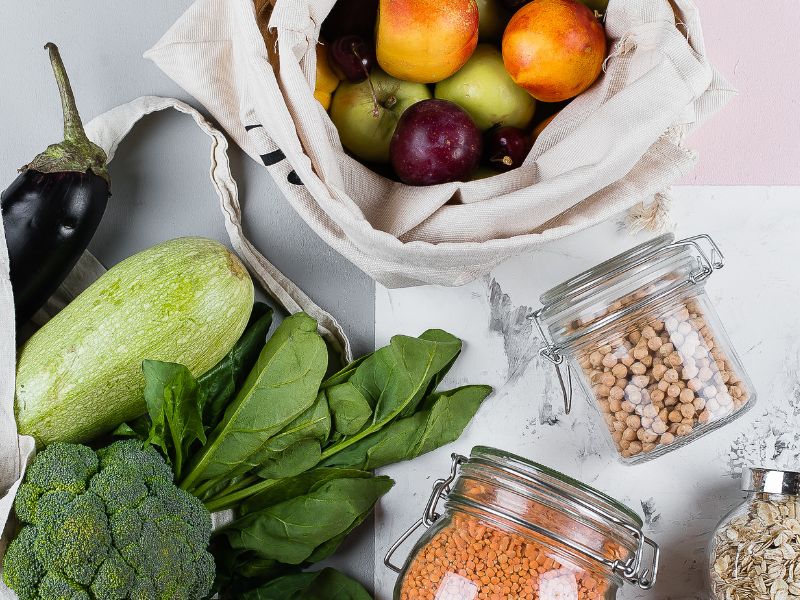Food Storage for Waste Prevention

Have you ever gone shopping for fresh fruits and veggies to find you’re surprised by how much plastic packaging you see around them? It is not uncommon to see fruits sold in plastic clamshell containers or plastic bags offered to bag loose vegetables at most grocery stores. Depending on what you’re looking to buy sometimes the packaging is unavoidable. But don’t fret, we’ve gathered a few of our favorite smart strategies to help you shop sustainably, prevent waste and store your food so it will last longer!
- Use reusable vegetable bags. You can use these instead of the individual plastic bags when opting to buy loose produce rather than pre-packaged. These are often made of cloth or a fine mesh to allow airflow through making them great for fridge storage as well as transportation. Best of all you can machine wash these and use them over and over again!
- Know what goes where for optimal storage. Vegetable bins and crisper drawers are great storage options to help keep your food fresher longer. Some vegetable bins even have a means for helping to absorb ethylene gas as the produce ripens. This gas is responsible for ripening vegetables but may cause produce to ripen too quickly when contained. Some variations have a colander-type tray that nests inside of the tub and keeps the vegetables from touching the sides or bottom of the tub, allowing you to add a bit of water to the bottom to help maintain proper humidity inside. Just be sure the vegetables are not sitting in the water!
- Sometimes specific fruit and produce do better when stored on the counter or in the pantry. Be in the know about where specific foods should be stored with the “Save the Food” interactive storage guide.
- Keep it contained! Storing leftovers or prepped meals for the week in air-tight glass containers in the fridge or freezer is a great way to keep pre-cooked food fresh and tasty. You could also use glass jars repurposed from sauce, salsa, or peanut butter for an easy and free travel container. This blog post has great plastic-free storage options we love!
Produce-Specific Plastic-Free Storage
What about all your fruits and vegetables that are usually stored in plastic bags? Here are some no-plastic storage tips:
• Store artichokes, carrots, and celery in bowls of cold water in the fridge.
• Store avocados, strawberries, figs, and any other berries in a paper bag.
• Store beets, Brussels sprouts, cucumbers, green beans, and radishes in open glass containers covered with a damp towel in the fridge.
• Store cauliflower, herbs, and cherries in closed glass containers in the fridge.
• Store broccoli rabe, corn, snap peas, spinach, and cut melon in open glass containers in the fridge.
• Store greens in closed glass containers covered with a damp cloth in the fridge.
• Store cabbage, eggplant, and spring onions right in the fridge crisper.
If you freeze meat and fish, wrap them in natural parchment paper. Simply wrap and tie with a bit of poultry twine! This is also a great way to store sandwiches in the fridge.
There are many environmentally-friendly options that not only help you to reduce your own personal plastic footprint but also help in keeping your vegetables fresher for longer. In addition to being sustainable and often reducing plastic consumption, they have the added benefits of reducing food waste and saving you money!
Maximize Food Lifespan
Beyond storage practices for each item, there are many other tricks to making sure your food gets eaten. Organize your fridge to optimize eating habits, have a “back up” practice like using a freezer to extend shelf life, and get inspiration on how to use even the most obscure ingredients. Check out resources below for more information on how to set up your kitchen as a no-food-waste success!
- Prep now, eat later – food prepping tips from the EPA
- Keep Fruits and Vegetables Fresher Longer – Solana Center blog post
- Keep these foods stocked in the freezer – 13 great uses for a freezer from Huffington Post
- No Leftover Recipe Guide – gives you recipe ideas to use up any ingredient
- Sustainable Food Storage – keep food fresh with sustainable packaging
Even if we are using optimal storage techniques, sometimes things don’t go as planned. Understanding the shelf life of our food can help us plan. There are also lots of great tricks to repurposing food that is still safe but is not quite appetizing. But it is also important to know when to call it quits. You can learn about all of these topics on our page: when to repurpose versus dispose of.
Article was written with assistance by Solana Center volunteer Mark.
